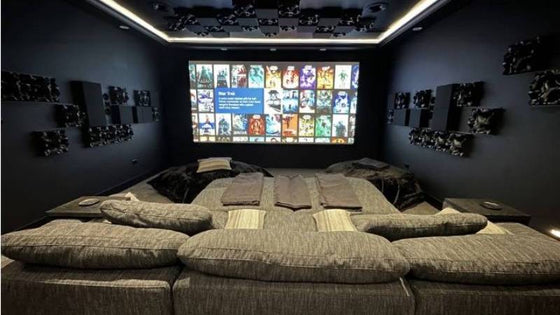Creating a system you love shouldn't be difficult. The Acoustic Frontiers blog is here to help.
Acoustic absorbers help balance the spectrum of direct and reflected sounds.
Absorber panels at wall and ceiling reflection points can be used to better match the spectrum of direct and reflected sounds. The ear is demanding in its requirement for the spectrum of direct and reflected sounds to be spectrally similar. If they are not then significant spatial and timbral distortion can result.
What thickness of fiberglass do I need?
It is important in critical listening rooms and home theaters that any fiberglass based absorber used at primary reflection points be at least 3" thick. This is to maintain constant absorption down to the transition frequency at around 250Hz. 1" or even 2" thick fiberglass absorbers do not meet this requirement and will produce spectral distortion when used to treat reflection points.
1" fiberglass, for example, only has constant absorption down to 800Hz or so. A 1" fiberglass panel only absorbs 25% of the incident energy at 250Hz compared to 100% at 800Hz. This means that the reflected sound from a 1" absorber will be spectrally distorted compared to the incoming sound. Given that as much as 60% of what we hear in our listening rooms and home theaters is from reflected sounds it is obvious that if 1" absorbers are used liberally in a room that sound quality will be severely impacted.
The diagram below shows the absorption curves for three different thicknesses of fiberglass absorber:

What about acoustic foam?
Acoustic Frontiers does not at the current time recommend acoustic or acoustical foams for high end audio, home theater or studio applications since over twice the thickness (i.e. 6") is required to meet the contant absorption requirement explained above.
Acoustical panels can be used to reduce excessively long decay times
Long decay times are generally caused by a lack of acoustical absorption within your room. The audible impact is listener fatigue, loss of low level detail and timbral distortion. Learn more about decay times in our Acoustics University.
This media room was intentionally designed to feel like part of the home—not a separate, tech-heavy space. Through careful acoustic planning, equipment integration, and final calibration, we achieved a room that is both beautiful to live in and immersive to experience.
"No other subwoofer system I’ve owned even comes close to what this room delivers. Reaching out to Acoustic Frontiers was one of the best decisions I’ve made—I highly recommend working with them if you want to get the most out of your theater."

Nyal Mellor, Founder, Acoustic Frontiers



Nyal Mellor
Author